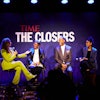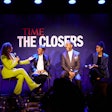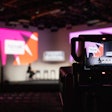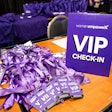A streamlined AV experience is essential to a successful event. We asked experts to help deconstruct the complexities of the AV world to equip event coordinators of all experience levels with new information to employ at upcoming conferences.
What's Trending in AV
Prior to planning any event, take stock of what concepts and equipment are currently rocking the audiovisual world and how they might help achieve your program’s goals. LED technology remains among the hottest elements in the AV business today. “It offers incredible flexibility for doing custom-sized projections, and you can have a lot of fun with it, like adding curves in the screen,” says Scott Frankel, president of Animatic Media based in Hicksville, New York. Another plus, especially for budget-conscious planners, is that LED screens have become much more affordable. Video mapping—creating custom content to fit into a specific size and shape of a projection area such as a church interior—is another trend on Frankel’s radar. So too is social media integration, where visual walls are created (at a general session, seminar or banquet) that use preprogrammed hashtags to search for and project content. This could be a Twitter feed, for example, of attendees registering their thoughts as the event progresses. Louis Cooper, president of Cooper Interactive in San Diego, sees 360-degree livestreaming continuing to grow. “It gets the audience into the meeting and is more than just a still picture,” he says. Basic cameras like the Samsung Gear 360 and the Insta360 Nano remain affordable (around $100-$200), while Facebook now supports live, 360-degree video streams for compatible cameras and smartphones. “A lot of our clients are interested in virtual and augmented reality,” says Lindsay Meck, director of production at Sequence Events in New York City. While VR relies on geeky visors and headsets for engagement, “AR is alive in the environment,” says Meck. Waving a phone or tablet over a decal could activate and display a secret image. Case in point: the recent “Pokemon Go” craze, where players searched for “hidden” creatures that could only be seen on their smartphones. (Apple, already a fan of the technology, is adding faster processors to its new iPhones in anticipation of a coming AR surge.) Meck says drones are also trending for aerial projections and imagery.Budgeting for AV
While it’s never too early to start planning a budget, your first steps should focus on firming up a program’s overall requirements—your message, its audience and the best means of delivery—before getting into potential costs. “Don’t waste time working on a budget until you have real information on room usage, session agenda and AV needs,” says Scott Frankel. For example, know the proper screen sizes for the expected number of attendees. “You don’t need the brightest projector unless you’re in an uncontrolled environment that’s very bright,” he says. Ditto for sound: Make sure it’s clear and crisp, but don’t overdo it. Managing expectations is also critical. “Consider the message you want to send to attendees, because it will help you set realistic goals,” says Maureen Olson, executive vice president of sales and business operations for Video West in Phoenix. A grander message could equate to greater expenses, “but it doesn’t always take a lot of money to achieve your goals,” she says. Before booking, consider carefully all aspects of bringing in an AV company, from ballroom rental and power usage to labor and things like Internet access. “The more you embellish the look of your meeting, the more expensive it will become because of those charges,” says Olson.
Site selection, for both the destination and specific venues, also plays a key role in determining AV expenses. While big cities like New York, Chicago and San Francisco are big draws for attendees, they can also prove expensive when hiring workers. “For labor, you always need to consider your setup times and agenda so as to not cause overtime, short turns or meal penalties,” says Frankel.
Planners should always work out and understand the details of an AV setup prior to signing a contract. “Get a few competitive bids from AV vendors and ask that they write out or explain the equipment as a narrative versus an inventory list,” says Lindsay Meck. This helps clarify what each item is being used for and whether it’s essential to your event.
AV 101
Integrating audiovisual into a meeting program isn’t rocket science, but it does require some mental investment to comprehend AV technology and how it fits into the meeting itself.Pay attention to the big picture(s).
A major component of meetings is sharing content on screens or monitors, so confirm all the projection details (e.g., fonts, resolution, aspect ratio, power access) beforehand, allowing enough time to test your files to be sure your hard work will be displayed beautifully during your program.Sound advice.
A frequent challenge in larger- scale events is ensuring all audience members can hear what’s going on. A professional AV company should provide ample, even levels of sound throughout an event space and make sure all speakers or presenters feel comfortable with their microphones.
Keep tabs on your content and its delivery.
Your checklist should account for things like computer-switcher compatibility; where and when music is required; the number and types of microphones, including Q&A mics; and any extra lighting needed to record an event.
Spread the AV wealth.
Audience attention spans are shorter than ever, so consider using satellite stages to break up longer events, such as awards shows and general sessions, to keep attendees engaged.
Question everything.
Make sure your vendor has your best interest in mind by quizzing them about all AV aspects, from equipment and talent to placement and installation.Test-drive your AV system.
Take a seat in the banquet hall, ballroom or seminar room and soak up the sound and lights from the attendees’ point of view, noting things like blocked sight lines or bad acoustics.Work in some “wow.”
AV is all about the experience, whatever the price point. Use color, light and sound to engage attendees in something truly memorable.Spend Smart, Save More
A set budget shouldn’t preclude cutting AV costs whenever possible.
Utilize your 501(3)(c) nonprofit status.
When booking AV, “You can typically find vendors that will apply a discount,” says Cooper.Consider purchasing—rather than renting—certain equipment.
“If you do the same type of meeting over and over again, it can pay to invest in your own projector or presentation computers,” says Frankel.Comparison shop, then swap.
“Lectern mics tend to be more cost-effective and easier for presenters than lavaliers,” says Meck, while monitors (plasma screens) tend to be less expensive than projection screens.Find yourself an AV BFF.
When planning repeated, smaller and mid-sized regional meetings, consider working a deal with one AV vendor to cover multiple projects.Go gray.
To turn a simple room into something elegant, use gray draping with LED uplighting. “It absorbs any color you put on it and is a budget-conscious way to make something out of nothing,” says Frankel.Socialize.
Options abound for using social media—notably Facebook, Twitter and Instagram— to expand and engage attendees, while costing little or nothing but time to employ.
Language Lesson
The AV world has a lingo all its own. Here’s a handy list of useful terms, courtesy of pros Scott Frankel and Lindsay Meck.
Aspect Ratio: The proportion of height to length on projection screens
Gobo: A custom lens, inserted into a lighting fixture, displaying a brand logo or graphic onto a wall, floor or other surface
Switcher: A device allowing seamless movement from one computer to another
Rigging: A truss framework, connected to a ceiling or roof structure, which allows you to hang or suspend audio, lighting, video and scenic designs above ground
Stage Wash: Lighting that floods the stage so presenters are not standing in the dark
Cue Sheet: Provides cues and instructions to the lighting, audio, video and stage management team on event details
Speaker Timer: A small digital clock facing presenters on stage that counts down their allocated speaking time
PerfectCue: A light-and-sound signaling system enabling a speaker to remotely control presentation software
Stage Manager/Showcaller: Person in the AV tech booth who manages lighting, sound and video operators
Lav/Lavalier: Small microphone that attaches to a lapel or shirt collar















